The Technics 1200 series of turntables need no introduction given their now  legendary status, but the Japanese company’s latest incarnation going by the name 1200 G is a whole new ball game. Stuart Smith gives this £3000 record player a spin.
legendary status, but the Japanese company’s latest incarnation going by the name 1200 G is a whole new ball game. Stuart Smith gives this £3000 record player a spin.
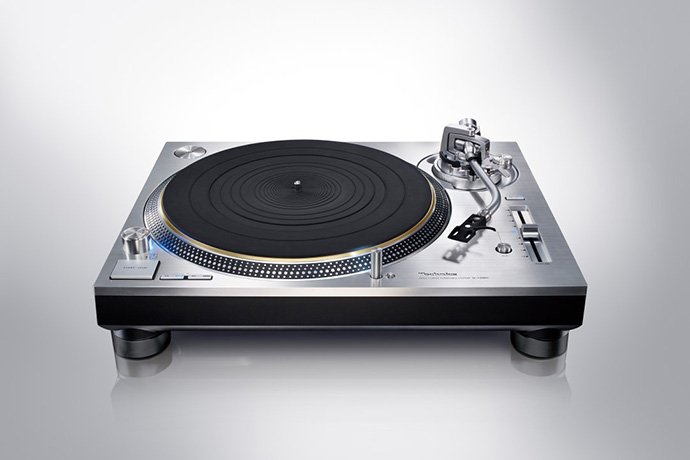 Regular readers of Hifi Pig will know that I have had a long-time love affair with the Technics 1200 series of turntables having first acquired a pair around 1989 in exchange for a Linn Sondek LP12, Musical Fidelity The Pre Amp and a Crimson Electric power amplifier. It hurt to see that little setup go, but having a pair of 1210s and a mixer opened up a whole new world of possibilities for me and shaped where my life went from there on in. As well as using the trusty Technics war-horse for DJ duties I also had a pair in the record shop we owned and latterly I’ve had a few of the older models to modify with different arms, bearings and power supplies – to greater or lesser degrees of success. I am a strong believer that the 1210 mkv in its standard form is a very good turntable and don’t really care what folk have to say about it being a DJ Turntable.
Regular readers of Hifi Pig will know that I have had a long-time love affair with the Technics 1200 series of turntables having first acquired a pair around 1989 in exchange for a Linn Sondek LP12, Musical Fidelity The Pre Amp and a Crimson Electric power amplifier. It hurt to see that little setup go, but having a pair of 1210s and a mixer opened up a whole new world of possibilities for me and shaped where my life went from there on in. As well as using the trusty Technics war-horse for DJ duties I also had a pair in the record shop we owned and latterly I’ve had a few of the older models to modify with different arms, bearings and power supplies – to greater or lesser degrees of success. I am a strong believer that the 1210 mkv in its standard form is a very good turntable and don’t really care what folk have to say about it being a DJ Turntable.
Let’s get this straight from the off shall we and avoid any confusion – the Technics 1200 series of turntables were originally made for home use by savvy Japanese audiophiles who understood the benefits associated with a direct drive motor with regards to speed stability. The original SL-1200 was introduced in 1972 as the natural evolution to the company’s SL-1100 and in 1979 the MK2 models were introduced with improved damping and the now familiar sliding pitch control. Now, I fully understand where the pitch control comes in when DJing and beatmatching, but I’ve never really understood the need for its inclusion on a deck for home use. Never mind, had the slider not been included, I doubt the 1200 would have found favour in the DJ community. The models have changed slightly and evolved over the years and there have been several special editions culminating in the current models and including the SL-1200G we have here which was released at CES in 2016.
FEATURES AND CONSTRUCTION
Direct drive turntables have one inherent benefit over their belt drive cousins and that is built-in pitch stability – play piano on a turntable that is not pitch-stable and you’ll get the message as to why pitch stability is so important. All the 1200 series of turntables have employed direct-drive motors but the latest 1200G uses a newly-developed coreless motor with no iron core. It has a twin-rotor construction to reduce bearing load and which is said to reduce micro-vibrations during spinning.
We then come on to the platter itself, and on this particular iteration of the 1200, one of the first things that jumps out at you is the brass disc on top of the aluminium die-cast platter, which itself has a deadening rubber covering to its back surface. All this adds mass to the platter which Technics says helps to get rid of resonance and improves rotational stability. The platter is checked at the factory for balance and gets a sticker to say it has been checked. The platter weighs a cool 3.6kg.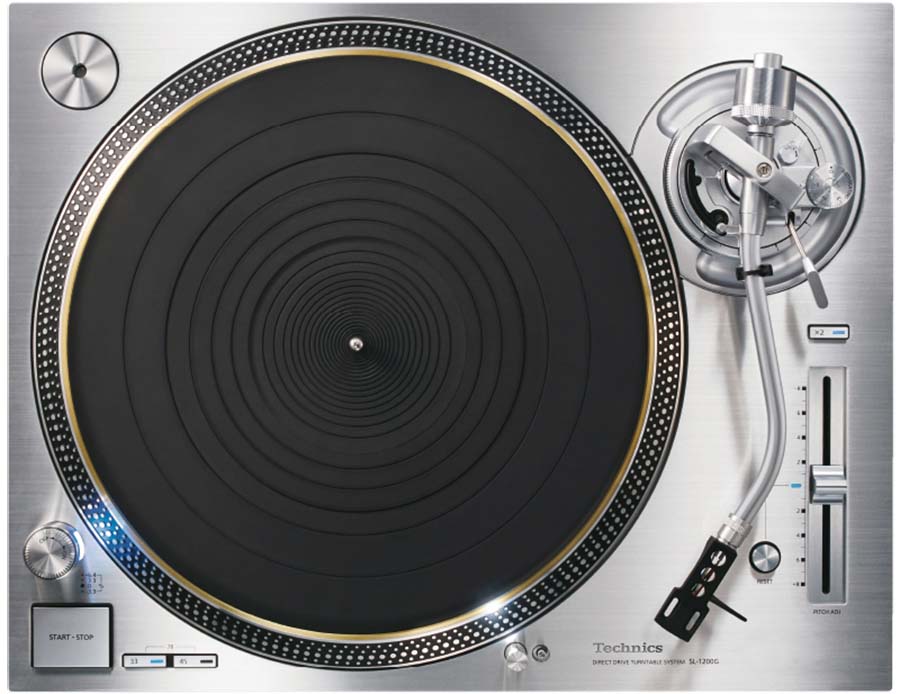
The tonearm is the traditional S-Shape that anyone familiar with Technics 1200 turntables will immediately recognise, but this arm is a little different to what has gone before. Instead of Aluminium, the tonearm on the 1200G uses lightweight Magnesium which Technics says has a higher damping effect. The tonearm uses Technics gimbal suspension construction and uses high-precision bearings. I’ve heard people say that the big downfall of the 1200s has been the tonearm, but I just do not get this and feel that even the standard arms on previous models would take higher-end cartridges without issue and without being embarrassed. VTA can be altered using the simple but effective locking system that is effectuated by simply unlocking and twisting the wheel on the bottom of the tonearm and then relocking it. Simple and effective! There is a tonearm lift and the headshell is the SME type detachable style which makes life nice and simple when you want to change cartridges.
Previous models of the 1200 have had flying RCAs and Ground coming from the tonearm, but on the 1200G you get RCA sockets and a ground post that allows for the use of any cables you fancy. This is a useful addition for those of you out there who want to have a play with different cables. You also get a IEC input so you can play with different power cables should that take your fancy.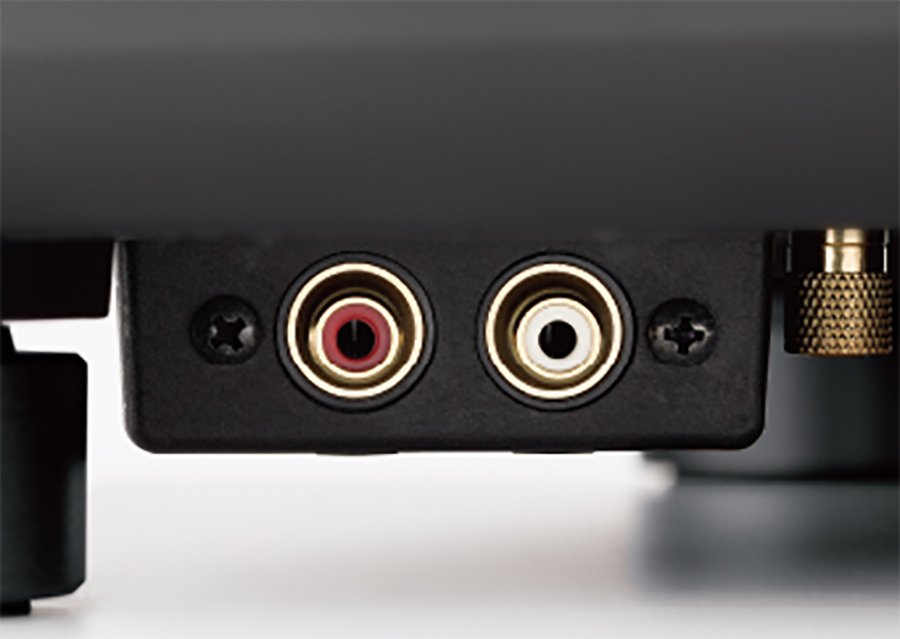
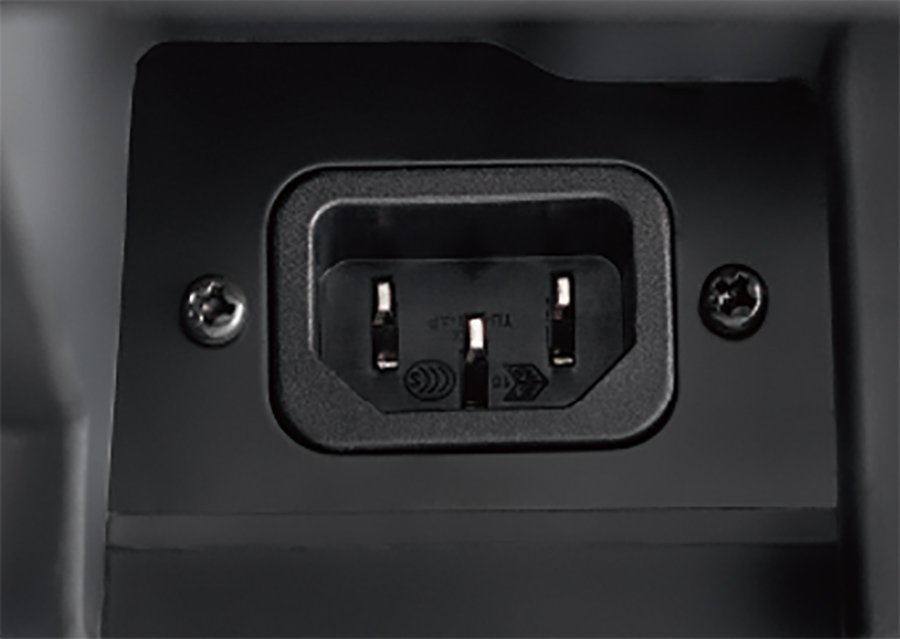
The actual body of the turntable is made up of a four-layer construction of a 10mm thick Aluminium top panel on top of the die-cast Aluminium frame, BMC and heavy rubber which makes up the bottom layer.
The 1200G will spin all your 33s, 45s and even your 78s with the ability to adjust the speed should you feel the urge. It has a starting torque of 3.3kg/cm which means that no sooner have you got the platter spinning than it’s up to desired speed. In fact, for 33RMP the platter will be up to speed in an impressive 0.7seconds. Wow and Flutter are stated as being 0.025% and rumble 78dB.
Size-wise the 1200g is the standard 453 x 173 x 372mm (WHD) and it weighs in at a total of 18kg.
Set up is as simple as you can get with a turntable. Unpack it, pop it on your rack, get the turntable levelled using the adjustable feet, add the cartridge of your choice, connect the cables and ground to the phonostage of your choosing and that’s it.
From the off things feel reassuringly sturdy and solid with a workman-type feel to proceedings. Gimmicks are few and far between on the 1200 and the controls on the top panel are all pretty self-explanatory. On the left you have the on off knob and then a big start/stop button, then the speed selection buttons, the pop up light that is also a strobe so you can obsess about whether the turntable is spinning at the right speed (it was and always did) and then the sliding speed control which can be doubled up to +/- 16% (you used to have to take your 1210s apart and perform an adjustment internally to get a bigger range from the standard 8%). To be fair, I never had the slider in anything other than the 0 position and, apart from DJs, I don’t really see the need for this other than to make the turntable attractive to DJs as well as home users…so probably a pretty smart move on the part of Technics thinking about it. You also get a hinged dust cover.
That’s your lot and it all looks familiar and intuitive to use and I was eager to get going.
I bolted on our trusty Audio Technica AT0C9cartridge, checked VTA (so easy to alter it’s untrue!) and what not and we were off.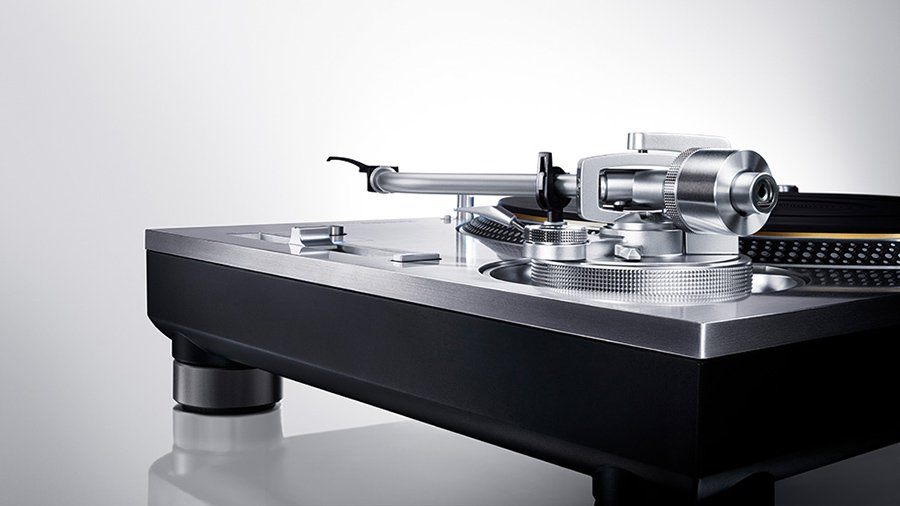
SOUND QUALITY
A turntable really shouldn’t be a thing that you listen to in my opinion; the turntable itself can be seen as the bit of kit that turns the record at the right speed and allows the cartridge to get as much information out of the grooves on the record and adding as little of its self to the sound as is possible. Of course, this is an all but impossible task to ask of any bit of kit and the mechanical nature of playing vinyl records makes the job all that more difficult with pretty much everything conspiring to add something to the signal that is sent to the phonostage. There are different ways of trying to minimise the effect the turntable has on the overall sound with isolation (sprung chassis) and mass (heavy turntables) being the most prevalent, though there are other “solutions”. The Technics isn’t sprung and it’s not particularly heavy either, though it is “substantial” in this respect. I read many years ago that the 1200 was considered to be a “dark” sounding turntable which I’ve never really understood. To me, saying that a product comes across as being dark suggests that the overall tonal balance is a little flat or missing sparkle in the top-end, neither of these can be said of the 1200 and so I’m at a loss as to what that particular reviewer was banging on about. However, I digress.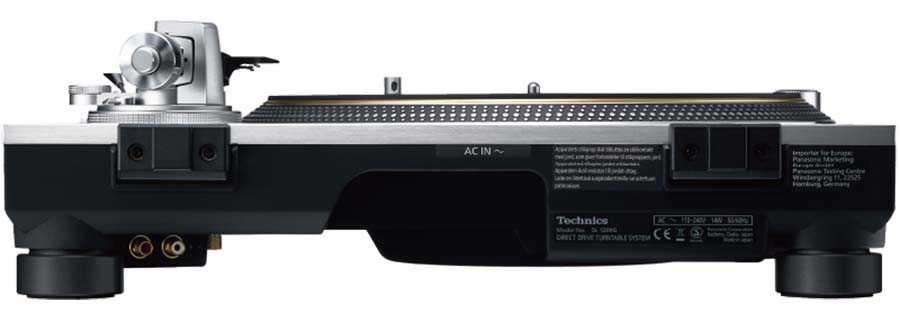
Pitch stability is absolutely cock-on with this turntable and playing any piano tune demonstrates this perfectly (as mentioned earlier). There is no wobble or deviation from the pure tone of the piano and this is consistent with whatever kind of track you play. I’ve had discussions about speed stability with turntable manufacturers in the past and at least one has said that we are not as susceptible to variations in pitch as we would like to think we are. I disagree with this statement, and whilst I’m in no way suggesting I’m some kind of golden-eared wunderkind, it is something that drives me nuts when done badly – surely it cannot be too difficult to get a record player to spin at a consistent speed, or perhaps it is. This pitch stability is a big part of the 1200Gs appeal to me, as it has been with all the iterations of the 1200, and it’s not just manifested when playing piano tracks. Timing-wise the 1200G is absolutely solid and this solidity adds weight and slam to the music you play. Playing some early techno from the Tresor label has the Teutonic beats (marching music an old friend used to call it) presented solidly and with real oomph. That bass kick (let’s not forget that this kind of music is machine-made and like the 1200G is locked into a tempo with laser-like precision) is solid and forthright, but also with plenty of detail with regards to effects used and the make-up of the kick sound itself. You see, that speed stability creates a solid backing track for whatever is placed over it, and in turn those sounds that are overlaid become more distinct from the background, leading to a more three-dimensional portrayal of the mix. Layering and positioning of instruments in the mix is great with a “reach out and touch” quality to the sound image and what is important is instruments and sounds stay exactly where they should in the mix – and I do mean exactly in place. I suppose what I’m trying to get across here is that the 1200 G feels precise and controlled in the way it delivers music in the time domain and this has a beneficial knock-on effect to the way music is presented in its totality. Now, the old 1200s and pretty much all turntables that are direct drive, including the current crop of Technics 1200 and others have the same pitch stability I’m banging on about here, but with the G everything just seems more solid and more “right”. This then is obviously not just a result of the speed stability alone, all the other decks mentioned have this, and so something else is raising the G to new heights.
I’m drawn to play techno, hip-hop and the like on the G as this is the kind of thing I’d have played on its predecessors, but that would suggest that the new 1200 is a bit of a one-trick pony, and that just isn’t the case. Playing female vocals, and I’m reaching for the old favourite Songbird by Fleetwood Mac, has Christine McVie’s vocal presented beautifully and with bags of detail that allows me to fall into the tune, and the recording. This record, as most will know I’m sure, is recorded in an all but empty auditorium and you can hear the recording space and spatial elements in that three dimensional and stable image. That’s all great, but what really shines on this track on the G is how detailed the guitar track is. There is texture and detail and it stands on its own in the mix rather than the tune becoming a bit of a homologous mish-mash. That’s perhaps suggesting that the 1200 G is a bit analytical and clinical in its presentation and I don’t think I’m doing the record player a disservice in saying that is in fact the case. As mentioned earlier, the role of the turntable is to allow that little rock on the end of the cartridge’s cantilever to retrieve as much from the grooves as possible and get the information to the phonostage without adding much of itself, and this is precisely what the 1200 G manages to achieve. There’s a bit of a thing with Hifi reviews that as soon as the words clinical and analytical are mentioned the natural mental leap is to think that the reviewer is suggesting that the item in question is cold and lacking emotion, but let’s face facts here, what you actually want from a record player is for it to do its job and not to add anything to the equation – you actually want it to be clinical and analytical, with “flavour” coming from the choice of cartridge and other ancillaries you make. You know, there is constant and persistent chatter in audiophile circles of how this digital device or that (CD player, DAC, Streamer or whatever) is “analogue” in its presentation and I’d like to turn this analogy on its head a bit and suggest that the 1200G is in itself a bit digital in the way it behaves. And this is a good thing to my mind because what this turntable is doing is being truthful to what is in the grooves.
Am I suggesting that the 1200 G is absolutely neutral in its presentation? Of course not, and the G is not the perfect record player; I don’t think that exists, or I’m yet to hear it. There is a degree of colouration added to the final sound, over and above what the cartridge is adding, and I’m of the mind that this colouration is down to the toearm adding a degree of itself to proceedings. It’s not huge and it’s not going to diminish your enjoyment of this very good turntable, but it would be remiss of me not to mention it in this review.
Playing records that have quiet passages and the dead bits between records and you get an idea of actually how quiet this record player is in operation. I’m not going to get the stethoscope out (I don’t own one for a start) and listen to see if I can hear the inner workings of the G whilst its playing, but were I to do so I think I’d actually hear very little. The bearing is smooth as you could wish for and the motor (it’s not actually a motor as such) is deadly quiet and likewise smooth in operation. All this is positive and adds to the neutrality of this record player.
Let’s get the elephant in the room out the way, shall we? This turntable looks on the surface like a regular old Technics 1200 and yet it costs a whole lot more – it’s available in the UK at around the £3000 mark depending on where you shop – and if you look at it in those terms the G doesn’t look to represent decent value for money. But this is not a bog standard, common or garden 1200, it’s a lot more refined and with a lot more engineering going on inside than the normal 1200. There are some very, very good turntables out there at this kind of money and whether you get on with the G over and above others is going to be down to personal taste. For me it represents pretty good value, actually. It’s not cheap and three grand is a chunk of money in anyone’s terms, but take into account the fact that this is a solid, brilliantly engineered product that is all but plug, play and forget and the price begins to make more and more sense. Personally, I think the 1200 G is going to appeal to those music lovers that want excellent reproduction that is all but faithful to the recording, but don’t want the, let’s be honest, hassles of a high-end record player and all the set up it can take to get it performing at its best. No, the 1200 G takes no time to set up and once you have it plumbed in you can just get on with enjoying your tunes.
CONCLUSION
I don’t think I’m talking out of turn when I describe the 1200 G as being analytical as this is surely the holy grail of high-fidelity reproduction of music, but analytical does for some reason have negative connotations when used in audio. What the G does is spin the record at the correct speed whilst adding very little of its own flavour to the final sound. It’s not cold, it’s not clinical and it’s not emotionless…or perhaps it is if what we are saying by using these words is that the 1200 G is just a very accomplished data retrieval machine. Personally, and to my way of thinking, that makes the 1200 G a serious and worthy contender if what you are looking for is a faithful and honest workhorse that just gets on with what it is supposed to be doing without throwing a hissy fit if you dare touch it in the wrong place – as is the case with some more finicky designs.
If I was to be asked to describe the 1200 G as a car, I reckon I’d say it’s like a Porsche Boxter. It is relatively affordable in the grand scheme of things, very accomplished and will put a huge smile on your face, without needing to be taken to the main dealer every five minutes for this to be fine-tuned, or that to be reset. The Boxter, like the 1200 G, is a solid performer but without the supercar histrionics that can spoil the ownership experience. Neither the car or the turntable will leave you wanting much in terms of performance and fun but neither will have you forever tinkering to get the last ounce of performance out of them. I drive an original Boxter and I now have a 1200 G sat atop the Hifi rack in the mid-priced system and I think that is testament enough to give the 1200 G our highest accolade. There will be those that may want to change the arm down the line but having gone down that particular route in the past with previous 1200 models I’m just not feeling any compulsion to go down that path and I’m happy to just let the turntable sit there with me safe in the knowledge that when I go and put a record on it will perform just as it did the last time I played a record.
Audiophiles, and I’m including myself in this broad brush-stroke, are a special breed and it is in our very nature to fanny about changing this or that with our kit, but the 1200 G is just not like that. For this reason alone, I think there will be some folk out there that look at the 1200 G and feel it is not for them. Personally, and to use the car analogy again, I want to be able to walk to the garage, put the keys in the ignition of the car and enjoy the driving experience without having to mess about with set up.
You can tailor the 1200 G to your own personal tastes, but with the G you really only have the cartridge to play with (and perhaps the headshell and cables used). On this point, I think the cartridge I used for the duration was a very good choice and around the right price point, but I would have absolutely no qualms in popping a much more expensive cartridge on the G.
AT A GLANCE
Build Quality: Tank-like. Anyone familiar with the look of the 1200 series will immediately recognise this is from the same stable, but look a little deeper at the actual construction and you see this is a different kind of beast altogether.
Sound Quality: All but neutral with a little colour added by the arm. Solid, stable and detailed. One for those wanting accuracy and truth from their records. The player is very, very quiet in operation and in what it adds to the overall sound that comes out your speakers.
Value For Money: It’s good value in that it is a solid performer that is beautifully put together and will last you years to come without you having to do a thing to it. Forget trying to reference this to the standard 1200, it is not the same animal at all.
Pros: Great sounding and all but neutral in its presentation. Fit and forget. Solid and reliable. Set up is a doddle and once done you don’t need to mess.
Cons: Tinkerers will not like its plug and play nature. Arm does add a little colouration. Speed control a pointless expense for home use.
Price: £3000
Kit List: Audio Technica ATOC9, Graham Slee Accession phono, Atlas Cables interconnects, power cables, and distribution, Lab 12 pre and power conditioning, Merrill Audio Thor power amps, Jern loudspeakers, REL subs.
Stuart Smith











































































































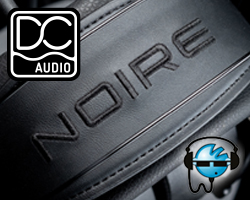





































































You must be logged in to leave a reply.